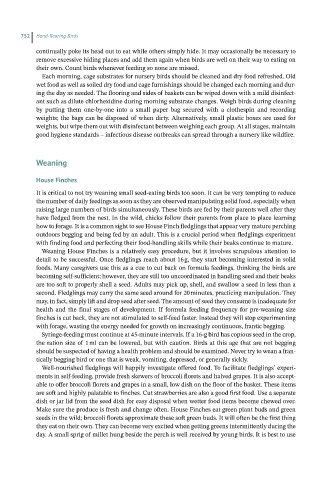Page 750 - Hand rearing birds second
P. 750
752 Hand-Rearing Birds
continually poke its head out to eat while others simply hide. It may occasionally be necessary to
remove excessive hiding places and add them again when birds are well on their way to eating on
their own. Count birds whenever feeding so none are missed.
Each morning, cage substrates for nursery birds should be cleaned and dry food refreshed. Old
wet food as well as soiled dry food and cage furnishings should be changed each morning and dur-
ing the day as needed. The flooring and sides of baskets can be wiped down with a mild disinfect-
ant such as dilute chlorhexidine during morning substrate changes. Weigh birds during cleaning
by putting them one‐by‐one into a small paper bag secured with a clothespin and recording
weights; the bags can be disposed of when dirty. Alternatively, small plastic boxes are used for
weights, but wipe them out with disinfectant between weighing each group. At all stages, maintain
good hygiene standards – infectious disease outbreaks can spread through a nursery like wildfire.
Weaning
House Finches
It is critical to not try weaning small seed‐eating birds too soon. It can be very tempting to reduce
the number of daily feedings as soon as they are observed manipulating solid food, especially when
raising large numbers of birds simultaneously. These birds are fed by their parents well after they
have fledged from the nest. In the wild, chicks follow their parents from place to place learning
how to forage. It is a common sight to see House Finch fledglings that appear very mature perching
outdoors begging and being fed by an adult. This is a crucial period when fledglings experiment
with finding food and perfecting their food‐handling skills while their beaks continue to mature.
Weaning House Finches is a relatively easy procedure, but it involves scrupulous attention to
detail to be successful. Once fledglings reach about 16 g, they start becoming interested in solid
foods. Many caregivers use this as a cue to cut back on formula feedings, thinking the birds are
becoming self‐sufficient; however, they are still too uncoordinated in handling seed and their beaks
are too soft to properly shell a seed. Adults may pick up, shell, and swallow a seed in less than a
second. Fledglings may carry the same seed around for 20 minutes, practicing manipulation. They
may, in fact, simply lift and drop seed after seed. The amount of seed they consume is inadequate for
health and the final stages of development. If formula feeding frequency for pre‐weaning size
finches is cut back, they are not stimulated to self‐feed faster. Instead they will stop experimenting
with forage, wasting the energy needed for growth on increasingly continuous, frantic begging.
Syringe‐feeding must continue at 45‐minute intervals. If a 16‐g bird has copious seed in the crop,
the ration size of 1 ml can be lowered, but with caution. Birds at this age that are not begging
should be suspected of having a health problem and should be examined. Never try to wean a fran-
tically begging bird or one that is weak, vomiting, depressed, or generally sickly.
Well‐nourished fledglings will happily investigate offered food. To facilitate fledglings’ experi-
ments in self‐feeding, provide fresh skewers of broccoli florets and halved grapes. It is also accept-
able to offer broccoli florets and grapes in a small, low dish on the floor of the basket. These items
are soft and highly palatable to finches. Cut strawberries are also a good first food. Use a separate
dish or jar lid from the seed dish for easy disposal when wetter food items become chewed over.
Make sure the produce is fresh and change often. House Finches eat green plant buds and green
seeds in the wild; broccoli florets approximate these soft green buds. It will often be the first thing
they eat on their own. They can become very excited when getting greens intermittently during the
day. A small sprig of millet hung beside the perch is well received by young birds. It is best to use

